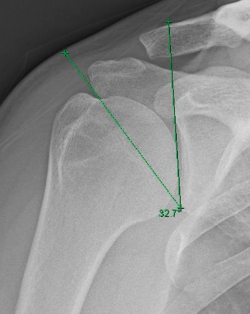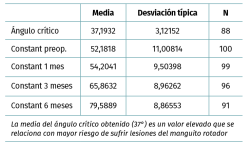Summary
Objetivo: el ángulo crítico del hombro es una medida radiológica que se ha relacionado con la patología degenerativa del manguito rotador. El objetivo fue investigar la relación existente entre este ángulo y los resultados funcionales tras la reparación artroscópica de las roturas del manguito rotador.
Métodos: estudio retrospectivo sobre 100 pacientes intervenidos por roturas degenerativas completas del manguito rotador. Las variables evaluadas fueron: ángulo crítico del hombro preoperatorio, edad, lateralidad, tipo de rotura, tipo de reparación, complicaciones y el test de Constant preoperatorio, al mes, 3 y 6 meses postoperatorio.
Resultados: la media del ángulo crítico fue de 37,19 ± 3,12° (32-46°) (prueba de Kolmogorov-Smirnov). El test de Constant preoperatorio obtuvo una media de 52,18 ± 11, al mes de 54,20 ± 9,50 (25-80), a los 3 meses de 65,86 ± 8,96 (30-85) y a los 6 meses de 79,58 ± 8,86 (40-95). Se encontró una relación estadísticamente significativa (p < 0,05) entre el tamaño de la rotura y el Constant preoperatorio (p = 0) y al mes (p = 0,013) (prueba T y de Mann-Whitney). Se observó una asociación no significativa entre puntuaciones mayores en la escala de Constant y valores de ángulo crítico menores al primer mes (p = 0,699) y al tercero (p = 0,764) (test de Pearson). Existió un porcentaje de incidencias postoperatorias del 14,7%.
Conclusiones: un valor elevado del ángulo crítico se relaciona con mayor riesgo de lesión del manguito al compararlo con otras publicaciones. Existe una asociación significativa entre el tamaño de la rotura y el test de Constant preoperatorio y al primer mes. No podemos confirmar una asociación significativa entre valores inferiores de ángulo crítico y valores superiores en la escala de Constant.
Nivel de evidencia: nivel III. Estudio de cohortes retrospectivo.
Relevancia clínica: se desconoce cómo influye un ángulo crítico elevado tras la reparación del manguito y si la propia cirugía podría alterar la evolución natural de la recuperación.
Abstract
Objective: critical shoulder angle (CSA) is a radiographic parameter which has been associated with degenerative tears of the rotator cuff. The purpose was to evaluate the relationship between the CSA and the functional outcomes after arthroscopic rotator cuff repair.
Materials and methods: this was a retrospective review of 100 patients with full-thickness tears who had undergone arthroscopic rotator cuff repair. Preoperative X-rays were used to measure the CSA. Tear size was determined intraoperatively. Constant score was assessed preoperatively, at 1 month, 3 months and 6 months. A single-row repair was done in all patients.
Results: average CSA was 37,19 ± 3,12° (32-46°) (Kolmogorov-Smirnov test). Constant score preoperatively was 52,18 ± 11, at 1 month 54,20 ± 9,50 (25-80), 3 months 65,86 ± 8,96 (30-85) and 6 months 79,58 ± 8,86 (40-95). A statistically relevant relation (p < 0.05) was found between the size of the tear and the preoperatory Constant (p = 0) and after one month (p = 0.013) (T and Mann-Whitney test). There was no significant difference between high Constant score values and low CSA values at 1 month (p = 0,699) and at 3 months (p = 0,764) (Pearson test). Postoperative incidences were 14,7%.
Conclusion: higher CSA is correlated with high risk of rotator cuff tear when compared to other articles. There is a significant association between the size of the tear and preoperative Constant score and at 1 month. A relevant relation between low CSA values with high Constant values cannot be confirmed.
Level of evidence: level III. Retrospective cohort design.
Clinical relevance: it is unknown both the impact of high CSA after the repair of rotator cuff and if the surgery itself may alter the natural development of recovery.
Article
Figures and tables
References
Downloads
Licence
Este contenido es de acceso abierto (Open-Access) y se ha distribuido bajo los términos de la licencia Creative Commons CC BY-NC-ND (Reconocimiento-NoComercial-SinObraDerivada 4.0 Internacional) que permite usar, distribuir y reproducir en cualquier medio siempre que se citen a los autores y no se utilice para fines comerciales ni para hacer obras derivadas.

